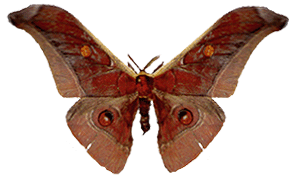|
Antheraea assamensis Helfer
Antheraea assamensis Helfer, 1837, J. Asiat. Soc. Bengal, 6: 43.
Antheraea brunnea van Eecke, 1922, Zool. Meded. Mus. Leiden, 6: 99.
Antheraea youngi Watson, 1915, Tijdschr. Ent., 58: 279.
Saturnia perotteti Guerin-Meneville, 1843, Mag. Zool. (2) 5 (9): 1.
Saturnia assama Westwood, 1848, Cabinet of Oriental Entomology, p. 41.
Antheraea mezankooria Moore, 1862, Trans. ent. Soc. Lond. (3), 1: 318,
Antheraea brunnea subvelata Bouvier, 1930, Bull. Hill Mus., Witley, 4: 92.
Antheraea assamensis mezops Bryk, 1944, Arkiv. Zool. 35A, 8: 7.
Antheraea assamensis rubigenea Toxopeus, 1940, Ent. Meded. Ned-Ind., 6:
14.
Antheraea assamensis youngi Watson; Allen, 1981: 117; Lampe, 1985: 12.

Antheraea assamensis 
(.61
natural size) |

Antheraea assamensis 
(.61
natural size) |
Diagnosis. The male is dark, rather purplish brown with slender, strongly
falcate forewings. The zone distal to the submarginal is distinctly paler
on the forewing. The female has prominent double white submarginals on a
dark brown ground, that of the forewing broadening into a triangle at the
apex, that of the hindwing looping round the ocellus anteriorly.
Taxonomic notes. The name youngi as used here applies to all Sundanian
populations of assamensis, distinguished by a darker, less rufous brown
ground colour. The taxon gschwandneri Niepelt, mentioned by Allen (1981),
is referable to A. celebensis Watson rather than assamensis.
Geographical range. India, Burma, Sundaland.
Habitat preference. The species has been taken infrequently in lowland
forests.
Biology. Arora & Gupta (1979) recorded the following host-plants for
Indian assamensis: Cinnamomum, Laurus, Litsea, Persea (Lauraceae);
Magnolia, Michelia (Magnoliaceae); Quercus (Fagaceae); Sarcostemma
(Asclepiadaceae);
Symplocos (Symplocaceae).
<<Back
>>Forward <<Return
to Contents page
|

